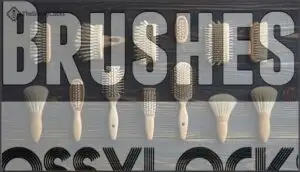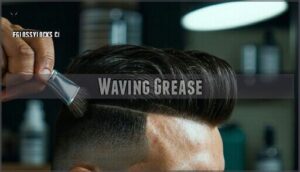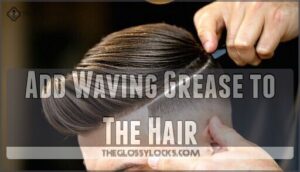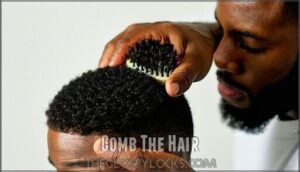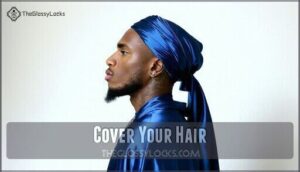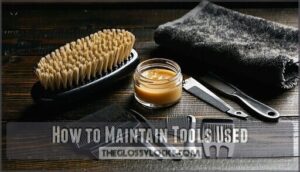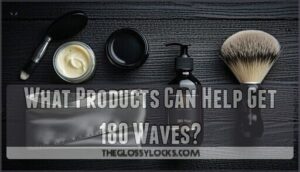This site is supported by our readers. We may earn a commission, at no cost to you, if you purchase through links.
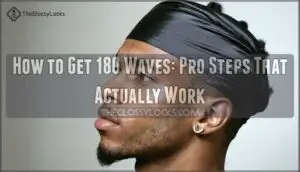
Start with smooth strokes from your crown straight down to your forehead while your hair’s slightly damp with product. That’s what creates those distinctive semicircular wave patterns that flow like ripples on water.
Hair texture makes a big difference here—coarser hair picks up wave patterns way faster than straight hair.
But honestly, it’s not just about having the right brush or products. The guys who really nail those crisp 180s understand when to brush, how much pressure to use, and the exact timing that turns decent waves into that mirror-like shine everyone’s chasing.
Table Of Contents
- Key Takeaways
- What Are 180 Waves?
- Tools for 180 Waves
- How to Get 180 Waves
- How to Maintain Tools Used
- What Products Can Help Get 180 Waves?
- What Tips Can Help Me Get 180 Waves?
- What Else Do I Need to Know to Get 180 Waves?
- Frequently Asked Questions (FAQs)
- How do you get 180 waves?
- How to get 180 waves with straight hair?
- How to maintain 180 waves?
- How long does it take to get 180 waves?
- How to master 180 waves?
- How to use 180 waves if your hair is dry?
- How often should I brush my hair to get 180 waves?
- How do I keep my hair from getting frizzy when I get 180 waves?
- Is there a difference between 180 waves and 360 waves?
- How do I know when I have reached 180 waves?
- Conclusion
Key Takeaways
- Master the fundamentals first – You need a boar bristle brush, sulfate-free shampoo and conditioner, waving grease, and a durag to create the foundation for proper wave formation.
- Perfect your brushing technique – Brush from your crown straight down to your forehead in smooth strokes while your hair is slightly damp with product, spending 10-15 minutes twice daily.
- Consistency beats perfection – Daily maintenance and wearing your durag overnight protects your progress – most guys see visible waves after 4-8 weeks of consistent effort.
- Hair texture determines your timeline – Coarser hair develops waves faster than straight hair, so adjust your expectations and technique based on your natural hair type.
What Are 180 Waves?
Ever wonder what makes some guys’ hair look like perfect ripples flowing across their head? That’s the magic of 180 waves – a hairstyle that creates a wave pattern flowing from your crown to your forehead.
Unlike 360 waves that circle your entire head, these waves focus on the top portion, creating striking ripples that flatter your face shape. This waves hairstyle works best with the right hair texture and can grab attention instantly.
Getting 180 waves takes time and the right technique, but man – when you nail it, people notice.
Tools for 180 Waves
Getting 180 waves isn’t rocket science, but you need the right gear to make it happen.
Here are the four must-have tools that can completely transform your wave game.
Brushes
Your brush isn’t just a tool – it’s the secret weapon that’ll make or break your entire wave game. A quality boar bristle brush distributes natural oils evenly while training your hair into those crisp wave patterns.
The bristle hardness matters – softer bristles work best for fine hair, while coarser textures need medium to firm bristles. Wave brushes with proper brush material create the foundation for effective wave training.
Regular brush cleaning prevents buildup that kills your progress. Master your brushing technique by working from crown to hairline, and you’ll see why serious wavers never compromise on their brush hair game.
Durag
A durag isn’t just another accessory—it’s the MVP of your wave routine. This game-changing tool delivers the right amount of compression your waves crave, especially during those crucial overnight hours when your hair pattern sets.
Quality Durag Materials like silk or satin reduce friction and lock in moisture. Proper Durag Maintenance involves regular washing to prevent buildup.
While Achieving 180 waves, your durag becomes essential for Maintaining 180 waves overnight, protecting your progress from pillow friction.
Conditioner and Shampoo
Here’s the thing about killer 180 waves—your shampoo matters just as much as your brush game. Skip the harsh sulfates and grab sulfate-free products made for textured hair instead.
Sulfates strip natural oils, leaving your scalp dry and waves lifeless. Quality hair care products with coconut oil and silk proteins maintain hydration without weighing down your hair.
Wash twice weekly to keep your scalp healthy while preserving those natural oils that make waves pop.
Waving Grease
Waving grease is like the secret sauce that transforms your brushing efforts from amateur hour into pro-level wave formation. These hair styling products create the foundation your waves need to lock into place.
Here are five key things to know about waving grease:
- Product Ingredients – Look for natural oils and moisturizers that protect your scalp without clogging pores
- Grease Application – Apply a thin layer before brushing to help hair lay down smoothly
- Wave Definition – Quality pomade enhances pattern visibility and adds shine
- Scalp Health – Choose non-comedogenic formulas that won’t irritate sensitive skin
- Grease Alternatives – Wave creams and wave enhancing products offer lighter options for fine hair
The right hair products make all the difference. Start with a dime-sized amount and work it through damp hair before your brushing session. Your waves will thank you.
How to Get 180 Waves
Getting 180 waves takes the right technique and consistent effort. Follow these four key steps to train your hair into that smooth wave pattern.
Wash Hair With Hair Conditioner and Hair Shampoo
Here’s the thing about clean hair and waves—it makes all the difference between looking like you know what you’re doing and looking like you just rolled out of bed.
When your scalp’s healthy, your waves actually have a fighting chance to form properly.
Start with sulfate-free products designed for textured hair. These conditioner types won’t strip your natural oils like harsh chemicals do. Wash your hair 2-3 times weekly—this shampoo frequency prevents buildup while maintaining moisture balance.
Focus on washing techniques that matter. Massage your scalp gently with fingertips, not nails. This stimulates blood flow and removes dead skin cells that block wave patterns. Look for product ingredients like shea butter, coconut oil, or argan oil in your shampoo and conditioner.
Your hair care products should work together. Use a moisturizing shampoo first, then follow with a leave-in conditioner that adds slip for easier brushing. Quality hair care sets the stage for everything that follows in your wave journey.
Add Waving Grease to The Hair
Now comes the magic ingredient that turns your freshly washed hair into a wave-making machine. Wave-enhancing products like pomade or waving grease create the foundation for proper wave definition while maintaining scalp health.
Here’s your grease application game plan:
- Start small – Use a dime-sized amount of product to avoid buildup
- Work it through – Distribute evenly from roots to tips with your fingers
- Choose wisely – Pick pomades with natural ingredients that won’t clog pores
- Consider alternatives – Wave creams offer lighter hold than traditional grease
The right hair product application sets you up for success in the next step.
Comb The Hair
This is where the magic happens – your brush becomes the conductor, and your hair follows the rhythm you set. Start from your crown and brush forward in smooth strokes. Use your boar bristle brush with steady pressure, creating the wave pattern through consistent brushing techniques. Each session should last 5-15 minutes.
| Brushing Element | Key Points |
|---|---|
| Direction | Crown to forehead, forward strokes |
| Pressure | Firm but gentle, consistent contact |
| Duration | 5-15 minutes per session |
| Pattern | Semicircular motion for wave development |
| Frequency | Multiple times daily for best results |
Cover Your Hair
Think of your hair like a freshly painted masterpiece – without protection, all that hard work can get messed up in minutes. That’s where durags and wave caps come in. These silk or satin covers provide night protection by reducing friction while you sleep. The smooth durag material keeps your waves locked in place and helps with moisture retention. Wave cap use isn’t just about looks – it’s about preserving your progress.
- Friction reduction prevents your waves from getting flattened against rough pillowcases
- Moisture retention keeps your hair hydrated overnight for better wave definition
- Wave pattern preservation maintains your brushing work while you’re not actively styling
How to Maintain Tools Used
Taking care of your wave tools is just as important as using them right. Clean brushes and fresh products will keep your waves looking sharp and prevent buildup that can mess up your pattern.
Remove Hair From Brush After Combing
Your brush picks up loose hairs every time you use it, and leaving them there is like trying to paint with a clogged brush.
Skip removing hair after brushing and you’ll end up with a tool that can’t do its job properly.
Hair buildup effects are no joke. Those tangled strands clog your boar bristle brush, making it work harder and less effectively. Your brush hair removal should happen immediately after every session—not tomorrow, not later, right now.
Here’s the deal: pull those loose hairs out with your fingers or use a comb to scrape them away. A clean brush distributes oils evenly and maintains proper hygiene importance for your scalp health.
Different brush type impact means maintenance varies. Boar bristle brushes need gentle cleaning frequency, while synthetic brushes handle rougher treatment. Make this part of your daily hair brushing ritual.
Clean tools create cleaner waves. Period.
Use The Conditioner and Shampoo in The Right Amounts
Too much shampoo strips your hair’s natural oils, while too little leaves buildup that blocks your wave pattern from forming properly. Use a quarter-sized amount of sulfate-free shampoo for scalp health. Deep conditioning once weekly maintains hair porosity and moisture balance.
- Apply conditioner from mid-length to ends, avoiding your scalp
- Wash hair 2-3 times weekly to preserve natural oils
- Choose products based on your hair’s specific ingredient needs
- Monitor washing frequency based on your hair care routine results
Wash and Dry Your Brushes
Your brush is like a trusty sidekick—it’ll only work as hard as you take care of it. Regular brush cleaning should be done weekly to prevent product buildup from pomades and oils. Start your brushing routine by removing loose hairs after each session—this keeps bristles working properly.
When washing, use mild shampoo in lukewarm water. Gently scrub the bristles to remove grease and debris that can clog your boar bristle brush. For sanitizing brushes, add a drop of tea tree oil to kill bacteria.
Proper drying techniques matter too. Shake out excess water, then lay the brush face-down on a clean towel. This prevents water from seeping into the handle and damaging your investment.
Clean brushes mean better brushing techniques for waves. When bristles stay flexible and debris-free, your daily brushing delivers consistent results. Bristle maintenance isn’t glamorous, but it’s what separates guys who get waves from those who just brush hair around.
Wash Your Hair Cover
A dirty durag wreaks havoc on your wave game. When your durag fills up with product buildup, sweat, and oils, it becomes a breeding ground for problems that mess with your scalp health if you skip washing it weekly.
Use gentle shampoo and warm water to wash your wave cap or durag, then rinse thoroughly to remove all residue. This washing technique prevents bacteria growth and maintains a proper hair care routine for waves.
Clean durags also work better at holding your wave pattern overnight. Let it air dry completely before your next session.
What Products Can Help Get 180 Waves?
Quality hair products make the difference between waves that fade fast and ones that last. Getting your product lineup right means your waves stay sharp all day long.
Here’s what actually works in the chair:
- Premium pomades with natural ingredients – Look for shea butter or coconut oil bases that won’t flake
- Silk or satin durag materials – These reduce friction by up to 50% compared to cotton
- Boar bristle brushes – Natural bristles distribute oils evenly without breaking hair
- Sulfate-free shampoo types – Gentle cleansing that won’t strip your hair’s natural moisture
Wave-enhancing products like quality moisturizer and wave creams give you the hold you need. Investing in a premium durag ensures consistent results and reduces the need for frequent replacements, contributing to long-term wave maintenance. Oil benefits include adding shine and preventing breakage during your brushing routine.
What Tips Can Help Me Get 180 Waves?
Look, getting 180 waves comes down to understanding what your hair actually needs.
Most guys miss this—coarse hair demands harder brushes and extra moisture, while fine hair responds way better to softer bristles and a lighter touch.
Here are four game-changing tips for achieving 180 waves:
- Master your wolfing period length—let hair grow 4-6 weeks between cuts to develop deeper wave patterns
- Choose silk or satin durag material choice over cotton to reduce friction and lock in moisture overnight
- Stick to consistent brushing technique—20-30 minutes daily, always brushing forward from crown to forehead
- Time your product application frequency—apply wave-enhancing products to slightly damp hair for better absorption
Your grooming practices for 180 waves should become second nature. Wave hairstyle techniques work best when you’re patient and consistent with your hair care routine for waves.
What Else Do I Need to Know to Get 180 Waves?
Beyond basics, scalp health determines your wave success. Poor scalp care causes 70% of wave failures, so keep it clean and moisturized. Your hair type matters too—coarse textures develop waves faster than straight hair. Product absorption peaks when hair is 60-70% damp.
Common mistakes include inconsistent brushing and switching brush types, which creates misaligned patterns. This style has roots in African American culture.
Sophisticated techniques like wolfing boost wave depth by 22%. Remember, consistency beats flawlessness in grooming practices for 180 waves.
Frequently Asked Questions (FAQs)
How do you get 180 waves?
Getting 180 waves isn’t rocket science, but it does take the right approach. You’ll need your hair texture to cooperate, a solid brushing game, and some patience to see those patterns develop.
Grab a quality wave brush and durag—these aren’t optional if you’re serious about results. The key is sticking to your daily routine and applying products correctly, because consistency beats everything else when you’re building lasting waves.
How to get 180 waves with straight hair?
Most people think straight hair can’t form 180 waves, but that’s where they’re wrong. Straight hair texture requires specific adjustments to traditional wave styling techniques.
Here’s what you need for wave formation with straight hair:
- Longer length – Keep hair around 2 inches instead of the usual 5 guard
- Forward brushing – Brush from crown to forehead using deliberate strokes
- Lightweight moisturizer – Heavy products weigh down fine hair types and waves
- Extended patience – Wave development time doubles compared to coarse textures
- Consistent routine – Daily hairstyle maintenance becomes even more critical
The key difference lies in brushing techniques and product recommendations designed for your hair type.
How to maintain 180 waves?
Maintaining your wave pattern upkeep requires consistent daily brushing and proper scalp health. Regular hair maintenance techniques prevent product buildup, while durag hygiene ensures moisture retention stays ideal.
| Daily Routine | Weekly Tasks | Monthly Care |
|---|---|---|
| Brush 20-30 minutes | Deep condition hair | Replace old durag |
| Apply light moisturizer | Wash brushes thoroughly | Trim hair edges |
| Wear durag overnight | Remove product buildup | Check scalp health |
Your hair care routines should focus on gentle cleansing without stripping natural oils. Use sulfate-free shampoos to maintain healthy hair while preserving your wave pattern. Clean your durag weekly to prevent bacteria growth that damages waves.
Hair health and maintenance depend on consistent moisture balance. Too much product creates buildup that flattens waves; too little leaves hair dry and brittle. Find the sweet spot through daily observation.
Professional hair maintenance means treating your waves like a craft. Brush from crown to forehead in smooth strokes. Never skip the durag—it’s your wave insurance policy. Maintaining 180 waves becomes second nature when you stick to proven techniques.
How long does it take to get 180 waves?
Most guys think waves appear overnight, but that’s like expecting a masterpiece in minutes. Wave development timeline usually spans 4-8 weeks depending on your hair texture impact and brushing frequency. Here’s the realistic breakdown:
- Weeks 1-2: Hair pattern starts responding to daily brushing sessions
- Weeks 3-4: Wave formation becomes visible with consistent product effectiveness
- Weeks 5-8: Full wolfing duration creates defined patterns through sustained hair growth
Your hair texture determines speed – coarser hair develops waves faster than fine hair. The wolfing technique requires patience as your weaving process gradually trains each strand into position.
How to master 180 waves?
Getting serious about 180 waves means brushing every day, picking the right products, and knowing how your hair works.
Focus on wave definition through structured maintenance schedules and refined brushing routines for best wave formation.
How to use 180 waves if your hair is dry?
Dry hair needs extra hydration before wave formation.
Apply a quality moisturizer or conditioner to damp hair, focusing on scalp health. Use olive oil for deep moisture, then proceed with your regular hair care routine.
How often should I brush my hair to get 180 waves?
Brushing frequency determines your wave progression success. You’ll need consistent brushing sessions twice daily for best pressure distribution across your hair texture.
Each brushing routine should last 10-15 minutes using your wave brush to establish the wave pattern and strengthen your brush game.
How do I keep my hair from getting frizzy when I get 180 waves?
Frizz happens when your hair loses moisture and gets disturbed during the wave-forming process. Here’s how to keep your waves smooth:
- Use quality pomade daily – Products like wave grease create a protective barrier that locks in hair moisture and prevents environmental factors from causing frizz
- Choose silk or satin durag material – These fabrics reduce friction while you sleep, protecting your brushing technique work from getting messed up
- Maintain proper hydration importance – Deep condition weekly and avoid product buildup by washing regularly to keep your hair health at its best
Your hair care routine for waves should focus on consistent moisturizer application and gentle handling to prevent disruption of your wave pattern.
Is there a difference between 180 waves and 360 waves?
Absolutely—these wave patterns have major differences in Wave Pattern Coverage and styling techniques. Your 180 waves only cover the top portion of your head, creating that signature front-to-back flow.
Meanwhile, 360 waves wrap completely around your entire head in continuous circles, demanding way more brushing time and intricate Hairstyle Complexity for that full wave game mastery.
How do I know when I have reached 180 waves?
You’ll recognize true 180 waves when distinct ripple visibility flows from your crown connection down to your forehead.
The wave pattern definition creates perfect S-curves with hairstyle fullness that transforms your hair game into flowing ocean-like patterns, bringing personal satisfaction to your hair transformation.
Conclusion
Mastering how to get 180 waves isn’t just about looking good—it’s about joining a brotherhood of wave masters who understand the craft.
Your dedication to proper brushing, quality products, and consistent maintenance will set you apart from those who give up after a few weeks.
Remember, your waves tell a story of patience and persistence. With the right technique and tools, you’ll turn heads and inspire others to start their own wave journey.
With waves, patience and technique turn heads and inspire others to master their own journey
- https://waversdreams.com/blogs/news/how-to-wash-and-style-360-waves-a-complete-guide
- https://www.lemon8-app.com/@supremespiral/7490564550635438635?region=us
- https://www.royaltyheadwear.com/blogs/news/how-to-get-180-waves-fast
- https://www.vogue.com/article/wavy-hair-routine
- https://evanalexandergrooming.com/blogs/the-den/wave-cap-vs-durag-which-one-is-best-for-hair-protection

